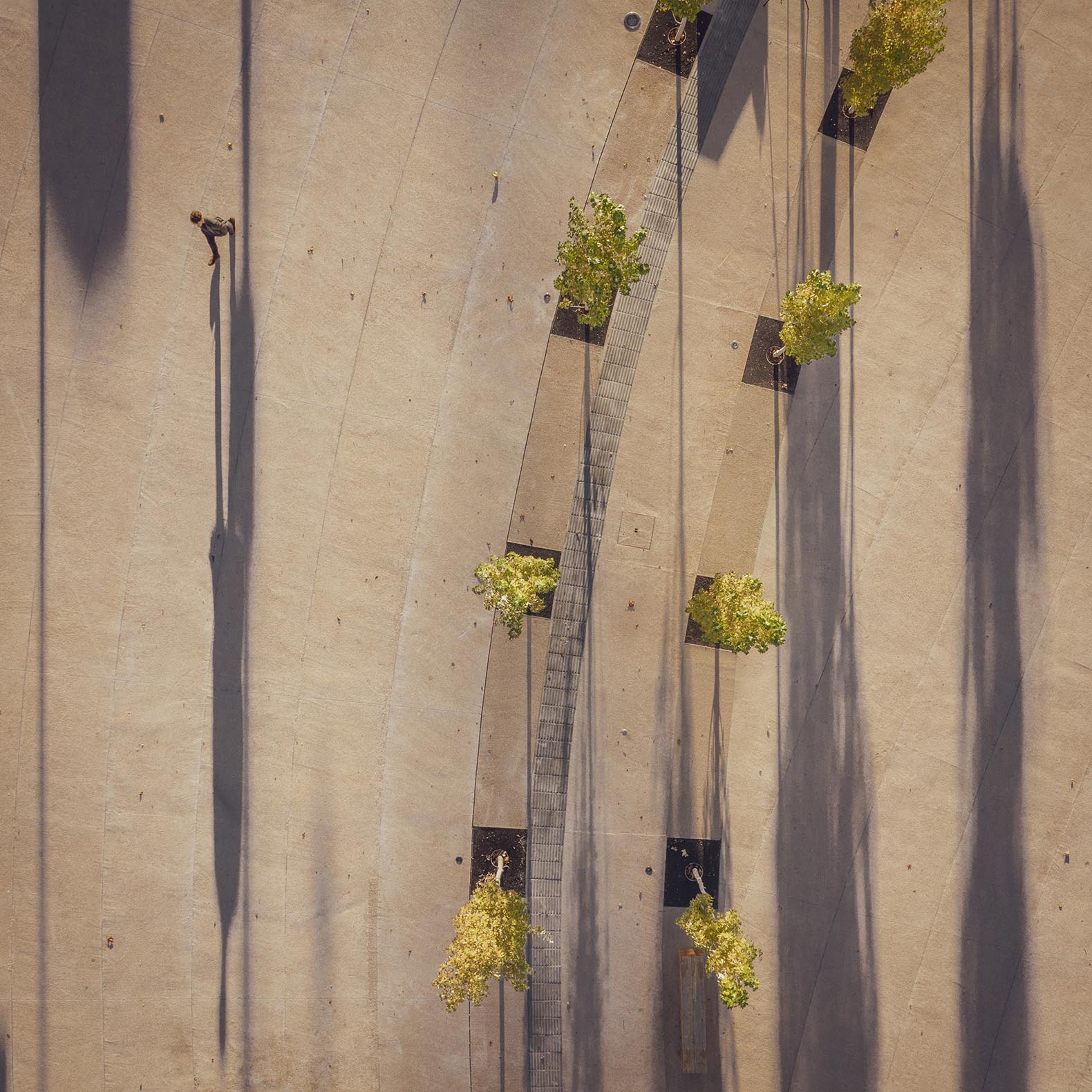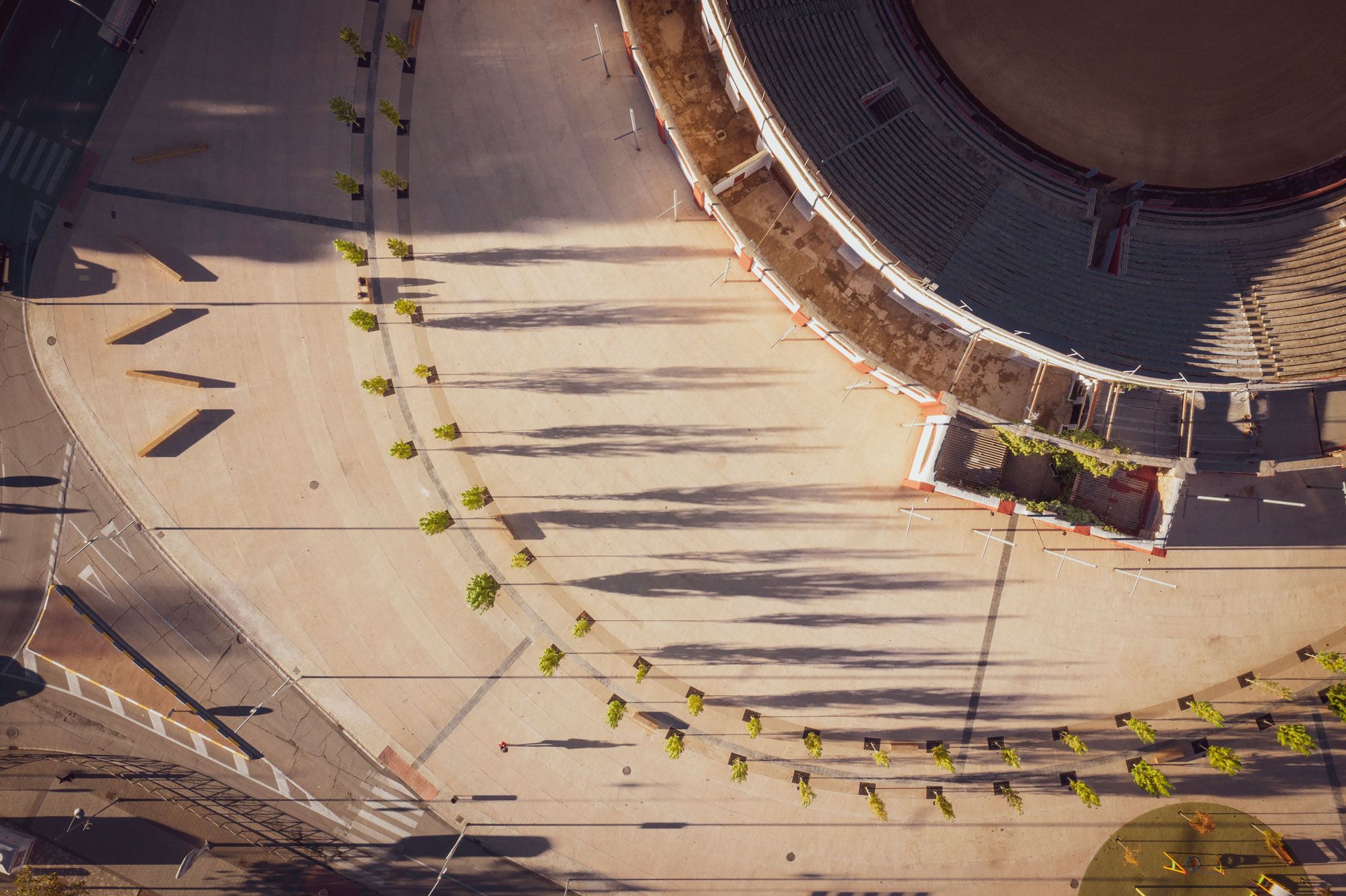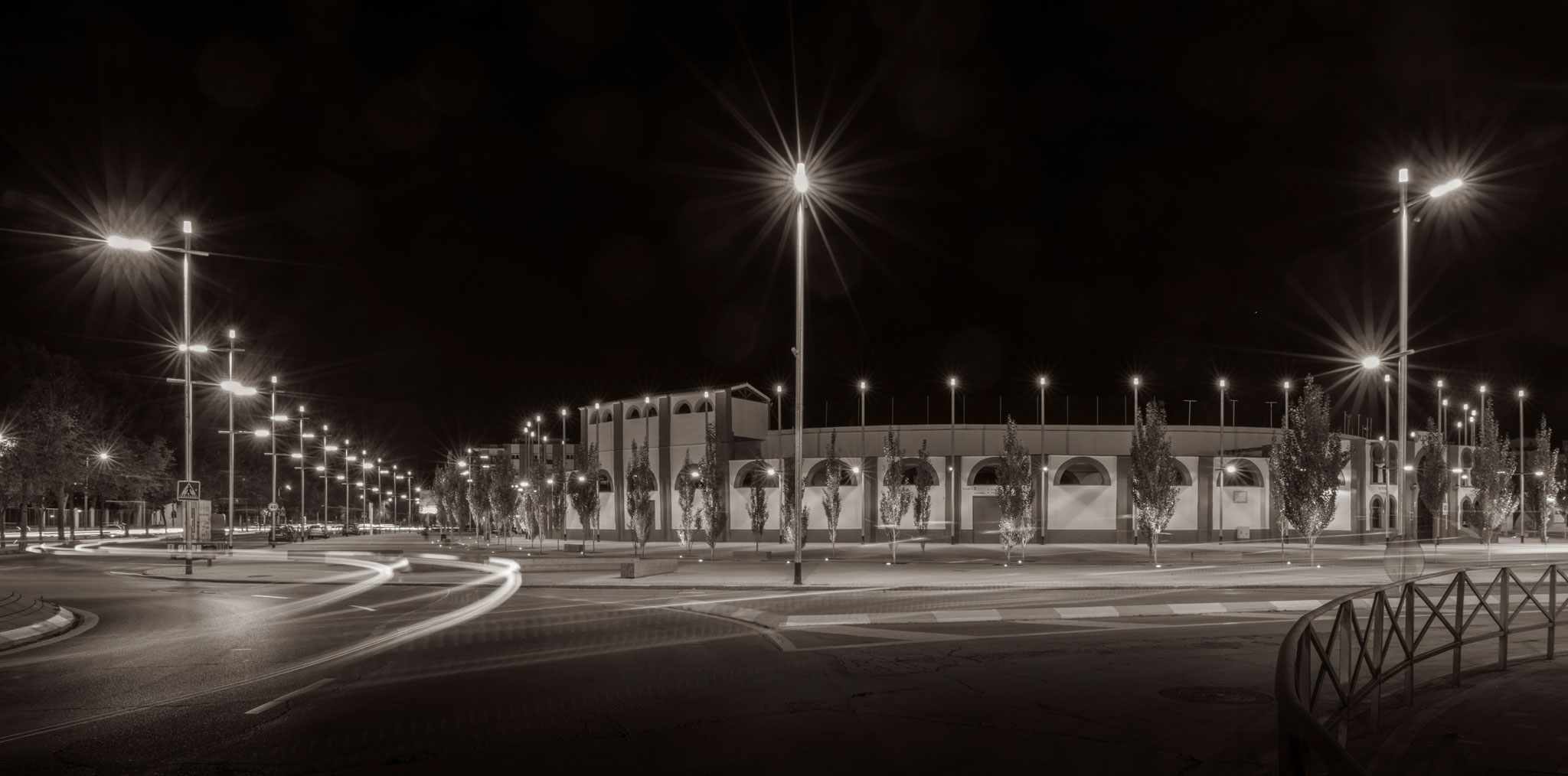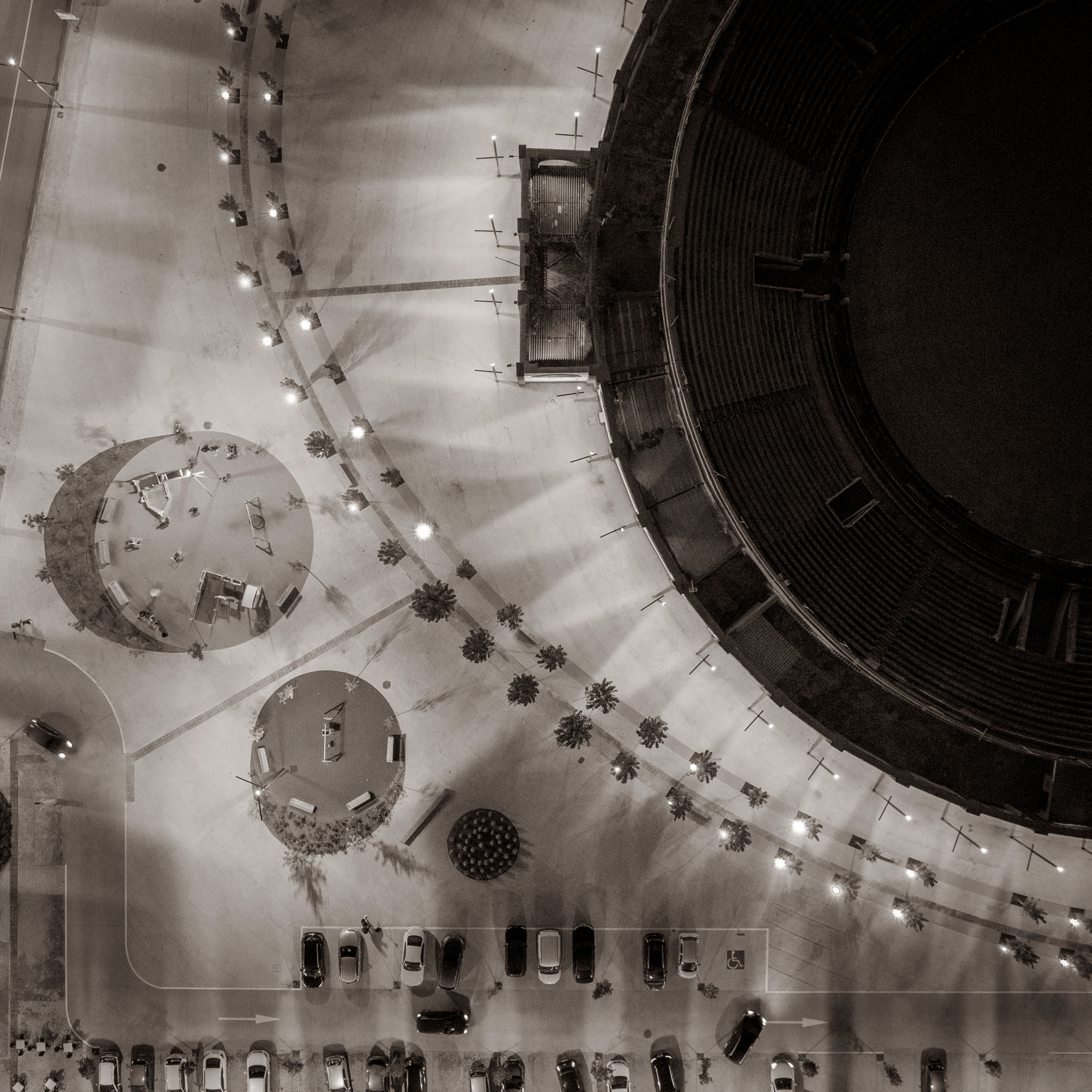The project is carried out by reducing the scale of the place thanks to different and subtle pavement treatments that are organized by means of a series of concentric ellipses defined by a new tree-lined ring of more than 200 poplars, a new green monumentality that recovers the memory of the boulevards that they separate the cultivated fields in the surroundings, as a walk and a place to stay.
The green ring is a visual, functional reference, and also the structural element that organizes all the installations of the intervention. From the air, the shape is reminiscent of a planet with rings and satellites, and small garden areas, which call to be and meet others.
The friendly and intelligent intervention turns the area into a close and active place, which changes at night and with the seasons of the year, a space that people appropriate.

Remodelling of the surroundings of Alcázar de San Juan bullring by Ramos Alderete. Photograph by Alberto Amores.

Remodelling of the surroundings of Alcázar de San Juan bullring by Ramos Alderete. Photograph by Alberto Amores.
Project description by Ramos Alderete
The commission, the result of the first prize in a public contest partially financed with European funds, consisted of the remodelling of the surroundings of the Plaza de Toros de Alcázar de San Juan. The area, of about 20,000m2, was in an unfortunate state of conservation: halfway between a square and an abandoned park, it had numerous dead trees and danger to citizens, with raised pavements, poor lighting...
However, it is a place of certain representativeness: in the centre of the space stands the Plaza de Toros, without a singular architectural value beyond its shape and the festivities that take place there, but strongly anchored in memory and culture. from town. It is also one of the entrances to the municipality, through which almost all the people of Alcazar pass often. It adjoins the large Parque Alces and a large avenue on one side, with an esplanade and a municipal swimming pool on the other, and with houses both low-rises and blocks on the other two sides: all very different sides.
Among the starting conditions are the need to use concrete pavement due to the constant traffic of heavy vehicles towards the Plaza de Toros and very unstable and floodable terrain, the rearrangement of traffic and parking spaces, the creation of an environment inclusive and giving space to possible events in the square, such as meetings or markets, giving the space flexibility that had not existed until now.
The objective of the project, in reality, was the recovery of that space, almost abandoned, for people: both at a functional level and at an evocative or identity level, capable of rearranging the environment with few elements given the tight budget available but proposing a space with a strong recognizable character.
Finding the scale, identity and character of that undefined space were one of the main challenges. To this end, a series of low-resource but high-impact strategies were used.
The first of these would be the creation of a single platform capable of offering support to any activity that unifies the entire set. The concrete of the pavement, made with local aggregate and white cement, is deactivated to find the colour of the earth there and the roughness of the grain. The coexistence and parking lanes and the central ring are made with grey cement and a different degree of deactivation, providing subtle changes to the pavement without losing its uniformity. Steel plates draw concentric circles to the square and the ring of trees, reducing the scale of the urban platform to the human scale.

Remodelling of the surroundings of Alcázar de San Juan bullring by Ramos Alderete. Photograph by Alberto Amores.
Around the Plaza de Toros, a ring of poplars encloses an enclosure whose centre is the Plaza itself. This ring recalls the avenues that separate the cultivated fields in the surroundings and is a walk and a place to stay. The boulevard, with its curved geometry, provides a latticework to the Plaza de Toros from the city, giving it back dignity, packing and unity. The Plaza is the centre and the origin, but the new monumentality is green. The few living trees are transplanted to the adjoining Park or conserved in the new action, while the wood from those already dead is recycled for wood chip floors or for the creation of some of the benches in the new square. The new plant colonnade becomes, in its dialogue with the Plaza de Toros, the icon of the place. This boulevard offers more than 200 new trees to those that were in its best times, but ordered, differentiating itself from the adjoining park. A square is not a park.
The green colonnade unifies the diverse surroundings and scales the plaza enclosing and defining urban rooms with a single gesture of powerful geometry. That magic ring contains everything: a gesture resolves the relationship with the surroundings, with the Plaza, with the Park. Also with time, when in autumn the leaves turn the place yellow, or in winter when the square is more visible when you would least look at it. The resounding geometry of the ellipse dialogues with the Plaza de Toros but is deformed by the stresses of the city. Its curves unify and integrate the different boundary conditions with a unique gesture that is alive, grows, changes colour and moves with the winds.
The central ring is not only a visual or functional reference but also the main infrastructure of the urban space, distributing from there all the main facilities, such as rainwater collection, electricity or irrigation, taking advantage of the fact that it is where most vegetation is concentrated.
Satellites around this ring contain islands where everyone can fit: children playing, fathers and mothers talking, and the elderly doing gymnastics... These satellites are landscaped and coloured in a dominant colour in vegetation, furniture, and pavement... creating smaller universes for close encounters.

Remodelling of the surroundings of Alcázar de San Juan bullring by Ramos Alderete. Photograph by Alberto Amores.

Remodelling of the surroundings of Alcázar de San Juan bullring by Ramos Alderete. Photograph by Alberto Amores.
The streetlights have been specifically designed for this project. A ring of light surrounds the Plaza de Toros. Lights on two levels mark their place in the city, on the near scale and on the far scale, and which, moreover, are supports for infinite possibilities. The Plaza de Toros is very short in proportion to the empty space. The colonnade of lampposts acts as a contemporary lattice that dignifies the Plaza de Toros, offering a larger scale. At night, the beacons on top of the posts accentuate the vertical axis of the central monument and create an immaterial ring in the air.
The project is still ongoing: architecture never ends. The leaves of the trees have taken on beautiful and surprising shades. The poplars planted in winter and that looked like just thin trunks grow fast, but at the same time slower than we would like for the photos: a whole lesson, for which we are grateful, of nature in the face of the immediacy of the culture of today: a reminder of what is important. In a few months, there are already some exhibitions and events (better and worse), and the procession of the Three Kings has even started from there. Now the project belongs to time and people.















































